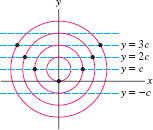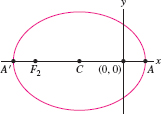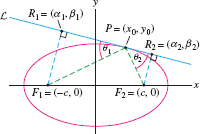11.15 EXERCISES
Preliminary Questions
Question 11.248
Which of the following equations defines an ellipse? Which does not define a conic section?
- (a) \(4x^2-9y^2= 12\)
- (b) \(-4x +9y^2= 0\)
- (c) \(4y^2+9x^2= 12\)
- (d) \(4x^3+9y^3= 12\)
Question 11.249
For which conic sections do the vertices lie between the foci?
Question 11.250
What are the foci of \[{\left(\frac{x}a\right)^2+\left(\frac{y}b\right)^2=1} \quad\text{if \(a \lt b\)?}\]
Question 11.251
What is the geometric interpretation of \({b}/{a}\) in the equation of a hyperbola in standard position?
Exercises
In Exercises 1–6, find the vertices and foci of the conic section.
Question 11.252
\({\left(\frac{x}9\right)^2 + \left(\frac{y}4\right)^2 = 1}\)
Question 11.253
\({ \frac{x^2}9 + \frac{y^2}4 = 1}\)
Question 11.254
\({\left(\frac{x}{4}\right)^2 - \left(\frac{y}{9}\right)^2 = 1}\)
Question 11.255
\({ \frac{x^2}{4} - \frac{y^2}{9} = 36}\)
Question 11.256
\({\left(\frac{x-3}7\right)^2 - \left(\frac{y+1}4\right)^2 = 1}\)
Question 11.257
\({\left(\frac{x-3}4\right)^2 + \left(\frac{y+1}7\right)^2 = 1}\)
In Exercises 7–10, find the equation of the ellipse obtained by translating (as indicated) the ellipse \[ \left(\frac{x-8}6\right)^2 + \left(\frac{y+4}3\right)^2 = 1 \]
Question 11.258
Translated with center at the origin
Question 11.259
Translated with center at \((-2,-12)\)
Question 11.260
Translated to the right six units
Question 11.261
Translated down four units
In Exercises 11–14, find the equation of the given ellipse.
Question 11.262
Vertices \((\pm 5, 0)\) and \((0,\pm 7)\)
Question 11.263
Foci \((\pm 6,0)\) and focal vertices \((\pm 10,0)\)
Question 11.264
Foci \((0, \pm 10)\) and eccentricity \(e=\frac35\)
Question 11.265
Vertices \((4,0)\), \((28,0)\) and eccentricity \(e=\frac23\)
In Exercises 15–20, find the equation of the given hyperbola.
Question 11.266
Vertices \((\pm 3, 0)\) and foci \((\pm 5,0)\)
Question 11.267
Vertices \((\pm 3,0)\) and asymptotes \(y= \pm \frac12 x\)
Question 11.268
Foci \((\pm 4,0)\) and eccentricity \(e= 2\)
Question 11.269
Vertices \((0,\pm 6)\) and eccentricity \(e= 3\)
Question 11.270
Vertices \((-3,0)\), \((7,0)\) and eccentricity \(e=3\)
Question 11.271
Vertices \((0,-6)\), \((0,4)\) and foci \((0, -9)\), \((0,7)\)
In Exercises 21–28, find the equation of the parabola with the given properties.
Question 11.272
Vertex \((0,0)\), focus \(\big(\frac1{12},0\big)\)
Question 11.273
Vertex \((0,0)\), focus \((0,2)\)
Question 11.274
Vertex \((0,0)\), directrix \(y=-5\)
Question 11.275
Vertex \((3,4)\), directrix \(y=-2\)
Question 11.276
Focus \((0,4)\), directrix \(y=-4\)
Question 11.277
Focus \((0,-4)\), directrix \(y=4\)
Question 11.278
Focus \((2,0)\), directrix \(x=-2\)
Question 11.279
Focus \((-2,0)\), vertex \((2,0)\)
In Exercises 29–38, find the vertices, foci, center (if an ellipse or a hyperbola), and asymptotes (if a hyperbola).
Question 11.280
\(x^2+4y^2 = 16\)
Question 11.281
\(4x^2+y^2 = 16\)
Question 11.282
\({\left(\frac{x-3}{4}\right)^2 -\left(\frac{y+5}{7}\right)^2 = 1}\)
Question 11.283
\(3x^2-27y^2 = 12\)
Question 11.284
\({4x^2-3y^2+8x+30y=215}\)
Question 11.285
\({y = 4x^2}\)
Question 11.286
\({y = 4(x-4)^2}\)
Question 11.287
\({8y^2+6x^2-36x-64y+134=0}\)
653
Question 11.288
\({4x^2+25y^2 -8x-10y= 20}\)
Question 11.289
\({16x^2+25y^2-64x-200y+64=0}\)
In Exercises 39–42, use the Discriminant Test to determine the type of the conic section (in each case, the equation is nondegenerate). Plot the curve if you have a computer algebra system.
Question 11.290
\({4x^2+5xy + 7y^2 = 24}\)
Question 11.291
\({x^2 - 2x y + y^2 + 24x - 8 = 0}\)
Question 11.292
\({2x^2 - 8xy + 3y^2 - 4=0}\)
Question 11.293
\({2x^2 - 3xy + 5y^2 - 4=0}\)
Question 11.294
Show that the “conic” \({x^2+3y^2-6x+12+23=0}\) has no points.
Question 11.295
For which values of \(a\) does the conic \({3 x^2 +2 y^2 - 16y + 12 x =a}\) have at least one point?
Question 11.296
Show that \({\frac{b}a = \sqrt{1-e^2}}\) for a standard ellipse of eccentricity \(e\).
Question 11.297
Show that the eccentricity of a hyperbola in standard position is \(e = \sqrt{1+m^2}\), where \(\pm m\) are the slopes of the asymptotes.
Question 11.298
Explain why the dots in Figure 11.108 lie on a parabola. Where are the focus and directrix located?

Question 11.299
Find the equation of the ellipse consisting of points \(P\) such that \(PF_1+PF_2=12\), where \(F_1=(4,0)\) and \(F_2=(-2,0)\).
Question 11.300
A latus rectum of a conic section is a chord through a focus parallel to the directrix. Find the area bounded by the parabola \(y=x^2/(4c)\) and its latus rectum (refer to Figure 11.93).
Question 11.301
Show that the tangent line at a point \(P=(x_0,y_0)\) on the hyperbola \({\left(\frac{x}a\right)^2-\left(\frac{y}b\right)^2=1}\) has equation \[ Ax-By=1 \] where \({A=\frac{x_0}{a^2}}\) and \({B=\frac{y_0}{b^2}}\).
In Exercises 51–54, find the polar equation of the conic with the given eccentricity and directrix, and focus at the origin.
Question 11.302
\(e=\frac12\),\(\quad\) \(x=3\)
Question 11.303
\(e=\frac12\),\(\quad\) \(x=-3\)
Question 11.304
\(e=1\),\(\quad\) \(x=4\)
Question 11.305
\(e=\frac32\),\(\quad\) \(x=-4\)
In Exercises 55–58, identify the type of conic, the eccentricity, and the equation of the directrix.
Question 11.306
\({r = \frac{8}{1+4\cos\theta}}\)
Question 11.307
\({r = \frac{8}{4+\cos\theta}}\)
Question 11.308
\({r = \frac{8}{4+3\cos\theta}}\)
Question 11.309
\({r = \frac{12}{4+3\cos\theta}}\)
Question 11.310
Find a polar equation for the hyperbola with focus at the origin, directrix \(x=-2\), and eccentricity \(e=1.2\).
Question 11.311
Let \(\mathcal C\) be the ellipse \({r={de}/({1+e\cos\theta})}\), where \(e \lt 1\). Show that the \(x\)-coordinates of the points in Figure 11.109 are as follows:
| Point | \(A\) | \(C\) | \(F_2\) | \(A'\) |
| \(x\)-coordinate | \({\frac{de}{e+1}}\) | \({-\frac{de^2}{1-e^2}}\) | \({-\frac{2de^2}{1-e^2}}\) | \({-\frac{de}{1-e}}\) |

Question 11.312
Find an equation in rectangular coordinates of the conic \[ r = \frac{16}{5+3\cos\theta} \]
Hint: Use the results of Exercise 60.
Question 11.313
Let \(e \gt 1\). Show that the vertices of the hyperbola \({r=\frac{de}{1+e\cos\theta}}\) have \(x\)-coordinates \({\frac{ed}{e+1}}\) and \({\frac{ed}{e-1}}\).
Question 11.314
Kepler's First Law states that planetary orbits are ellipses with the sun at one focus. The orbit of Pluto has eccentricity \(e\approx 0.25\). Its perihelion (closest distance to the sun) is approximately 2.7 billion miles. Find the aphelion (farthest distance from the sun).
Question 11.315
Kepler's Third Law states that the ratio \(T/a^{3/2}\) is equal to a constant \(C\) for all planetary orbits around the sun, where \(T\) is the period (time for a complete orbit) and \(a\) is the semimajor axis.
- (a) Compute \(C\) in units of days and kilometers, given that the semimajor axis of the earth's orbit is \(150\times 10^6\) km.
- (b) Compute the period of Saturn's orbit, given that its semimajor axis is approximately \(1.43\times 10^9\) km.
- (c) Saturn's orbit has eccentricity \(e=0.056\). Find the perihelion and aphelion of Saturn (see Exercise 63).
654
Further Insights and Challenges
Question 11.316
Verify Theorem 2.
Question 11.317
Verify Theorem 5 in the case \(0 \lt e \lt 1\). Hint: Repeat the proof of Theorem 5, but set \(c = d/(e^{-2}-1)\).
Question 11.318
Verify that if \(e \gt 1\), then Eq.(11) defines a hyperbola of eccentricity \(e\), with its focus at the origin and directrix at \(x=d\).
Reflective Property of the Ellipse In Exercises 68–70, we prove that the focal radii at a point on an ellipse make equal angles with the tangent line \(\mathcal L\). Let \(P=(x_0,y_0)\) be a point on the ellipse in Figure 11.110 with foci \(F_1=(-c,0)\) and \(F_2=(c,0)\), and eccentricity \(e=c/a\).
Question 11.319
Show that the equation of the tangent line at \(P\) is \(Ax+By=1\), where \({A=\frac{x_0}{a^2}}\) and \({B=\frac{y_0}{b^2}}\).
Question 11.320
Points \(R_1\) and \(R_2\) in Figure 11.110 are defined so that \(\overline{F_1R_1}\) and \(\overline{F_2R_2}\) are perpendicular to the tangent line.

- (a) Show, with \(A\) and \(B\) as in Exercise 68, that \[ \frac{\alpha_1+c}{\beta_1} = \frac{\alpha_2-c}{\beta_2} = \frac{A}B \]
- (b) Use (a) and the distance formula to show that \[ \frac{{F_1R_1}}{{F_2R_2}} = \frac{\beta_1}{\beta_2} \]
- (c) Use (a) and the equation of the tangent line in Exercise 68 to show that \[ \beta_1=\frac{B(1+Ac)}{A^2+B^2},\qquad \beta_2=\frac{B(1-Ac)}{A^2+B^2} \]
Question 11.321
- (a) Prove that \({PF_1} = a+x_0e\) and \({PF_2} = a-x_0e\). Hint: Show that \({PF_1}^2-{PF_2}^2 = 4x_0c\). Then use the defining property \({PF_1}+{PF_2}=2a\) and the relation \(e=c/a\).
- (b) Verify that \({\frac{{F_1R_1}}{{PF_1}} = \frac{{F_2R_2}}{{PF_2}}}\).
- (c) Show that \(\sin\theta_1=\sin\theta_2\). Conclude that \(\theta_1=\theta_2\).
Question 11.322
![]() Here is another proof of the Reflective Property.
Here is another proof of the Reflective Property.
- (a) Figure 11.110 suggests that \(\mathcal L\) is the unique line that intersects the ellipse only in the point \(P\). Assuming this, prove that \(QF_1+QF_2 \gt PF_1+PF_2\) for all points \(Q\) on the tangent line other than \(P\).
- (b) Use the Principle of Least Distance (Example 6 in Section 4.7) to prove that \(\theta_1=\theta_2\).
Question 11.323
Show that the length \({QR}\) in Figure 11.110 is independent of the point \(P\).

Question 11.324
Show that \({y = {x^2}/{4c}}\) is the equation of a parabola with directrix \(y=-c\), focus \((0,c)\), and the vertex at the origin, as stated in Theorem 3.
Question 11.325
Consider two ellipses in standard position: \begin{align*} E_1: \quad \left(\frac{x}{a_1}\right)^2+\left(\frac{y}{b_1}\right)^2 =1\\ E_2: \quad \left(\frac{x}{a_2}\right)^2+\left(\frac{y}{b_2}\right)^2 =1 \end{align*}
We say that \(E_1\) is similar to \(E_2\) under scaling if there exists a factor \(r \gt 0\) such that for all \((x,y)\) on \(E_1\), the point \((rx,ry)\) lies on \(E_2\). Show that \(E_1\) and \(E_2\) are similar under scaling if and only if they have the same eccentricity. Show that any two circles are similar under scaling.
Question 11.326
![]() Derive Equations (13) and (14) in the text as follows.
Write the coordinates of \(P\) with respect to the rotated axes in
Figure 11.106 in polar form \(x' = r\cos\alpha\), \(y' = r\sin\alpha\).
Explain why \(P\) has polar coordinates \((r,\alpha + \theta)\) with respect
to the standard \(x\) and \(y\)-axes and derive (13) and (14)
using the addition formulas for cosine and sine.
Derive Equations (13) and (14) in the text as follows.
Write the coordinates of \(P\) with respect to the rotated axes in
Figure 11.106 in polar form \(x' = r\cos\alpha\), \(y' = r\sin\alpha\).
Explain why \(P\) has polar coordinates \((r,\alpha + \theta)\) with respect
to the standard \(x\) and \(y\)-axes and derive (13) and (14)
using the addition formulas for cosine and sine.
Question 11.327
If we rewrite the general equation of degree 2 Eq.(12) in terms of variables \(x'\) and \(y'\) that are related to \(x\) and \(y\) by Eqs.(13) and (14), we obtain a new equation of degree 2 in \(x'\) and \(y'\) of the same form but with different coefficients: \[ a'x^2+b'xy+c'y^2+d'x+e'y+f'=0 \]
- (a) Show that \({b'=b\cos 2\theta+(c-a)\sin 2\theta}\).
- (b) Show that if \(b\ne 0\), then we obtain \(b'=0\) for \[ \theta=\frac12\cot^{-1}\frac{a-c}b \]
This proves that it is always possible to eliminate the cross term \(bxy\) by rotating the axes through a suitable angle.
655